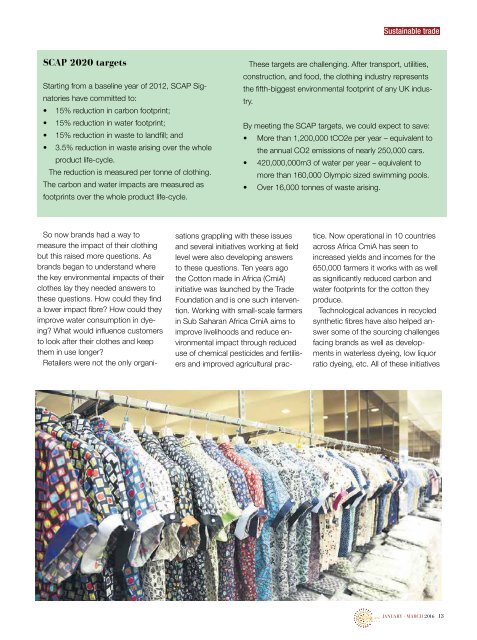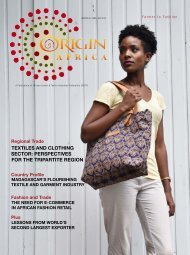You also want an ePaper? Increase the reach of your titles
YUMPU automatically turns print PDFs into web optimized ePapers that Google loves.
Sustainable trade<br />
SCAP 2020 targets<br />
Starting from a baseline year of 2012, SCAP Signatories<br />
have committed to:<br />
• 15% reduction in carbon footprint;<br />
• 15% reduction in water footprint;<br />
• 15% reduction in waste to landfill; and<br />
• 3.5% reduction in waste arising over the whole<br />
product life-cycle.<br />
The reduction is measured per tonne of clothing.<br />
The carbon and water impacts are measured as<br />
footprints over the whole product life-cycle.<br />
These targets are challenging. After transport, utilities,<br />
construction, and food, the clothing industry represents<br />
the fifth-biggest environmental footprint of any UK industry.<br />
By meeting the SCAP targets, we could expect to save:<br />
• More than 1,200,000 tCO2e per year – equivalent to<br />
the annual CO2 emissions of nearly 250,000 cars.<br />
• 420,000,000m3 of water per year – equivalent to<br />
more than 160,000 Olympic sized swimming pools.<br />
• Over 16,000 tonnes of waste arising.<br />
So now brands had a way to<br />
measure the impact of their clothing<br />
but this raised more questions. As<br />
brands began to understand where<br />
the key environmental impacts of their<br />
clothes lay they needed answers to<br />
these questions. How could they find<br />
a lower impact fibre? How could they<br />
improve water consumption in dyeing?<br />
What would influence customers<br />
to look after their clothes and keep<br />
them in use longer?<br />
Retailers were not the only organisations<br />
grappling with these issues<br />
and several initiatives working at field<br />
level were also developing answers<br />
to these questions. Ten years ago<br />
the Cotton made in <strong>Africa</strong> (CmiA)<br />
initiative was launched by the Trade<br />
Foundation and is one such intervention.<br />
Working with small-scale farmers<br />
in Sub Saharan <strong>Africa</strong> CmiA aims to<br />
improve livelihoods and reduce environmental<br />
impact through reduced<br />
use of chemical pesticides and fertilisers<br />
and improved agricultural practice.<br />
Now operational in 10 countries<br />
across <strong>Africa</strong> CmiA has seen to<br />
increased yields and incomes for the<br />
650,000 farmers it works with as well<br />
as significantly reduced carbon and<br />
water footprints for the cotton they<br />
produce.<br />
Technological advances in recycled<br />
synthetic fibres have also helped answer<br />
some of the sourcing challenges<br />
facing brands as well as developments<br />
in waterless dyeing, low liquor<br />
ratio dyeing, etc. All of these initiatives<br />
JANUARY - MARCH 2016 13



